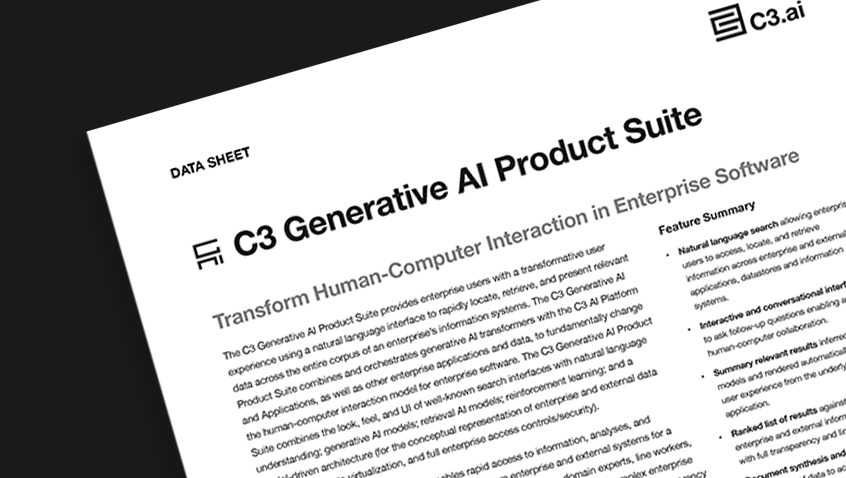- AI Software
- C3 AI Applications
- C3 AI Applications Overview
- C3 AI Anti-Money Laundering
- C3 AI Cash Management
- C3 AI Contested Logistics
- C3 AI CRM
- C3 AI Decision Advantage
- C3 AI Demand Forecasting
- C3 AI Energy Management
- C3 AI ESG
- C3 AI Health
- C3 AI Intelligence Analysis
- C3 AI Inventory Optimization
- C3 AI Process Optimization
- C3 AI Production Schedule Optimization
- C3 AI Property Appraisal
- C3 AI Readiness
- C3 AI Reliability
- C3 AI Smart Lending
- C3 AI Sourcing Optimization
- C3 AI Supply Network Risk
- C3 AI Turnaround Optimization
- C3 Generative AI Constituent Services
- C3 Law Enforcement
- C3 Agentic AI Platform
- C3 Generative AI
- Get Started with a C3 AI Pilot
- Industries
- Customers
- Events
- Resources
- Generative AI for Business
- Generative AI for Business
- C3 Generative AI: How Is It Unique?
- Reimagining the Enterprise with AI
- What To Consider When Using Generative AI
- Why Generative AI Is ‘Like the Internet Circa 1996’
- Can the Generative AI Hallucination Problem be Overcome?
- Transforming Healthcare Operations with Generative AI
- Data Avalanche to Strategic Advantage: Generative AI in Supply Chains
- Supply Chains for a Dangerous World: ‘Flexible, Resilient, Powered by AI’
- LLMs Pose Major Security Risks, Serving As ‘Attack Vectors’
- What Is Enterprise AI?
- Machine Learning
- Introduction
- What is Machine Learning?
- Tuning a Machine Learning Model
- Evaluating Model Performance
- Runtimes and Compute Requirements
- Selecting the Right AI/ML Problems
- Best Practices in Prototyping
- Best Practices in Ongoing Operations
- Building a Strong Team
- About the Author
- References
- Download eBook
- All Resources
- Publications
- Customer Viewpoints
- Blog
- Glossary
- Developer Portal
- Generative AI for Business
- News
- Company
- Contact Us
- Generative AI for Business
- C3 Generative AI: How Is It Unique?
- Reimagining the Enterprise with AI
- What To Consider When Using Generative AI
- Why Generative AI Is ‘Like the Internet Circa 1996’
- Can the Generative AI Hallucination Problem be Overcome?
- Transforming Healthcare Operations with Generative AI
- Data Avalanche to Strategic Advantage: Generative AI in Supply Chains
- Supply Chains for a Dangerous World: ‘Flexible, Resilient, Powered by AI’
- LLMs Pose Major Security Risks, Serving As ‘Attack Vectors’
- C3 Generative AI: Getting the Most Out of Enterprise Data
- The Key to Generative AI Adoption: ‘Trusted, Reliable, Safe Answers’
- Generative AI in Healthcare: The Opportunity for Medical Device Manufacturers
- Generative AI in Healthcare: The End of Administrative Burdens for Workers
- Generative AI for the Department of Defense: The Power of Instant Insights
Generative AI for the Department of Defense: The Power of Instant Insights
January 22, 2024
It’s hard to imagine an organization where generative AI will provide more value than the military. The ability to get reliable information in near real time can enable commanders to make life-and-death decisions based on insights that otherwise could take hours or days to retrieve. Intelligence operations. Contested logistics. Combat strategy. Generative AI will improve all aspects of military capabilities, across the entire U.S. Department of Defense (DoD).
We’re in the early days of generative AI, but the opportunity is great — and, given the escalating tensions with China, urgent. C3 AI discussed this and more with Graham Evans, a VP with C3 AI strategic partner Booz Allen. Evans has been supporting the DoD for more than a decade, working with military readiness and logistics.
Let’s start with the urgency.
Graham Evans: The military leadership has made it clear. The intelligence community believes that by 2027 or sooner, China will conduct some type of aggression in the Indo-Pacific region. All of the military planning today is really focused on a multi-threat environment in that region and being able to react quickly.
That’s going to be challenging given how disconnected the environment is we’d be operating in. From a contested logistic perspective, you think about the thousands of miles of coastline that the adversary would have to operate from and the hundreds of islands that make up the Indo-Pacific region. It becomes a logistical nightmare to try to operate effectively.
This is where AI, and generative AI, can help.
The use of AI in that context would allow for course-of-action planning and decision making on a scale and timeframe that would be conducive to responding to the military threat that we see. But when it comes to integrating AI, to meet the threat that is being predicted, I think there’s a long way to go.
Yet the vision of using generative AI in this context is to gain near instant insights.
That’s certainly the goal — being able to make decisions and being able to change behaviors more quickly, and to have human-machine teaming in an environment where there’s a lack of information. This is going to be paramount to successfully winning in that environment.
How do you help with the issue of data silos?
Part of my job is to help the government find its data and expose it in a secure manner so that it can be used for the purposes of analytics. The projects that we’re working with C3 AI on today enable us to do that.
Discoverability and understandability of data in the department is difficult because of the silos. But there are projects like Advana — the DoD’s big data platform for advanced analytics — that are striving to bring different organizations together to share information to break down the silos, for the purposes of a more enterprise approach to work towards AI and analytics in general.
Talk about the current use cases for generative AI.
The main one for now is information retrieval. There are countless documents of policy that DoD deals with. So, if somebody wants to understand the context of an action that they might want to take within available policy or within the context of strategy, that’s a really good use case for generative AI that we’re seeing today.
Some of the combatant commands are bringing large corpora of policy, memorandums, and information, and asking basic questions, like, “Is this within my authority to do?” That’s an immediate use case with great opportunity — searching across vast resources for specific capabilities that might be useful or data that might be useful for a particular application.
What does it take to deploy and integrate this kind of technology into a DoD environment?
The biggest thing is understanding all the different security policies and infrastructure constraints that are present in a DoD environment. That’s much different than a commercial environment. The timelines are much lengthier, the requirements are much lengthier, and in some cases, contradictory.
Then, a lot of the networks that these tools and capabilities reside on are highly secure and can’t take advantage of a lot of the modern infrastructure capabilities that you might see available to commercial industry. Not to mention the security processes and identity management components that are required to secure military applications are quite onerous.
Now you’re talking C3 AI’s playbook — with our focus on security and capabilities like access controls.
Because it’s so difficult to deploy disparate tools and capabilities, that’s another reason you’d want to have solutions like C3 AI’s, that package up some of those capabilities for easy deployment. For data scientists and analysts to build solutions and not have to worry about the pipes and infrastructure and connections and things like that, for a developer that’s really useful in a DoD environment.
Right. The DoD needs to know it’s getting reliable information.
When you’re thinking about an application that can be used in the context of an operational mission, you can’t sit there and think, was this a hallucination? I need to be able to act on the information that’s being presented to me by this model.



